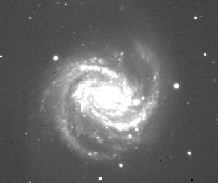


2.3.8. Hubble Space Telescope Distance Estimates to Virgo
The most recent determination of the distance to the Virgo cluster has made use of HST. Determination of the extragalactic distance scale and hence H0 is one of HST's key projects. Unfortunately, the initially aberrated optics of HST prevented this project from being done. In December of 1993, corrective optics were placed on HST and shortly thereafter, observations of the galaxy M100 (see Figure 2-22) in the Virgo cluster were carried out in order to detected individual Cepheid variables. This galaxy was chosen because
1) it is relatively face-on so that internal extinction is minimized
2) it has a high current star formation rate and hence a large population of Cepheids
3) it is the host galaxy of a well-measured SN Ia (SN 1979c) and hence a good distance to M100 will better calibrate the SN Ia luminosity scale.

|
Figure 2-22: Blue band CCD image of NGC 4321 (M100) obtained by the author. M100 is a prominent spiral galaxy in Virgo and was the first galaxy in Virgo searched with HST for Cepheids. M100 has also hosted 4 Supernova Ia since 1900. |
The detection and measurement of Cepheids in M100 is empirical proof that HST now performs up to its original expectations. Freedman et al. 1994 have detected about a dozen Cepheids in M100 and derive the relative M100 - LMC distance. Fixing the LMC distance at (m - M) = 18.5 yields a distance to M100 of (m - M) = 31.16 ± 0.2. Freedman et al. performed observations in both the V and I-bands to gain a color baseline which could be used to estimate the reddening towards the individual Cepheids in M100. Despite this, the ± 0.2 mag uncertainty in distance remains dominated by the uncertainty in reddening towards the Cepheids. This distance agrees well with the most recent estimates from others using HST Cepheid data for Virgo galaxies. Farrarese et al. (1996) derive (m - M) = 31.0 ± 0.2 for their sample of HST Cepheids while Saha et al. (1996) drive 31.10 ± 0.15 for NGC 4496 and 31.05 ± 0.15 for NGC 4536.
This distance of M100 is significantly lower than had been derived previously using the SN Ia luminosity calibration based on the distance to NGC 5253 and IC 4182 (whose distance has also been determined from HST observations of Cepheids). One can not reconcile this difference by changing the distance to the LMC as (m - M) = 18.5 is likely an upper limit. Hence, either the distances to NGC 5253 and IC 4182 are systematically high, resulting in a systematically high SN Ia calibration, or the photometry of Freedman et al. contains systematic errors or the reddening has been systematically overestimated. The actual light curves of the Cepheids are very well determined from the HST data and even though the WFPC detector has a relatively large random error in its photometric zeropoint (0.04 - 0.05 mag), there is no evidence for systematic errors in photometry. Thus it seems likely that this improved distance to M100 is also revealing a systematic error in the SN Ia luminosity scale. One possible source would be systematic errors in the 1937 photographic photometry itself (see Pierce and Jacoby 1992). In fact, it remains some what disconcerting that the TF, SBF and PNLF distance scale to Virgo can all be calibrated via Cepheid distances to nearby galaxies and all give a consistent distance to Virgo, yet that same calibration applied to SN Ia gives a significantly larger distance (Reiss et al. 1996). Clearly there is systematic error somewhere.
Deriving the distance to a large cluster of galaxies like Virgo, on
the basis of just one galaxy is problematical at best, as there
is no guarantee that the galaxy is in the cluster center. M100 is
a gas-rich spiral galaxy which strongly suggests that it cannot be
near the center of Virgo because there are various gas-removal mechanisms
operative in cluster centers. The observed redshift of M100 is
about 400 km/s higher than the mean Virgo redshift and it is located about
4 degrees away from the nominal cluster center (defined by M87). At
the mean distance of Virgo, this is a projected separation of
 1 Mpc.
Thus, while it is likely that M100 is a member of Virgo, its position and
redshift suggest that it lies about 10%
further away than the cluster center. Interestingly, at this distance,
M100 would have a linear diameter of
1 Mpc.
Thus, while it is likely that M100 is a member of Virgo, its position and
redshift suggest that it lies about 10%
further away than the cluster center. Interestingly, at this distance,
M100 would have a linear diameter of
 35 kpc,
making it one of the larger known late type spirals.
M100 has been the host of 4 SN which have occurred since
1901. This is an unusually high frequency of SN, which supports our claim
that M100 is an intrinsically large spiral. If M100 is 10% farther
away than the Virgo cluster center, then the distance
modulus to Virgo would be (m - M) = 31.05 ± 0.20 which is
in excellent
agreement with the TF, PNLF and SBF distance estimates. Using a distance
to the LMC of (m - M) = 18.35 lowers this distance to 30.90
± 0.20.
35 kpc,
making it one of the larger known late type spirals.
M100 has been the host of 4 SN which have occurred since
1901. This is an unusually high frequency of SN, which supports our claim
that M100 is an intrinsically large spiral. If M100 is 10% farther
away than the Virgo cluster center, then the distance
modulus to Virgo would be (m - M) = 31.05 ± 0.20 which is
in excellent
agreement with the TF, PNLF and SBF distance estimates. Using a distance
to the LMC of (m - M) = 18.35 lowers this distance to 30.90
± 0.20.